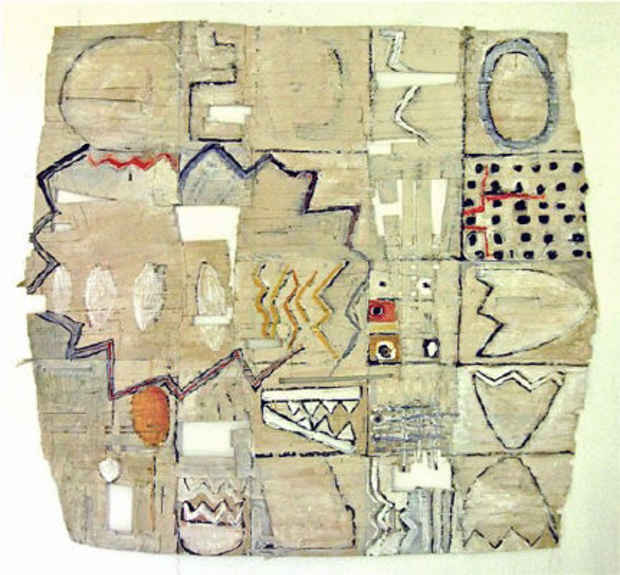“The Opposite Gaze” Exhibition
Howard Scott Gallery

This event has ended.
When Manet’s Olympia stared out implacably from the canvas in 1865, the “male gaze” had finally met its match. Since then, much has changed, but women still have not reached parity in the art world/market. This exhibition serves to put us on notice that, yes, women rule. “The Opposite Gaze” presents images that transcend gender stereotypes and issues, that resonate with their own intrinsic energy, that stand outside the limitations of trend and style.
From Sati Zech’s energy-filled collages, poignant and poetic, to Rebecca Salter’s deep, absorbing contemplations of line and layering, and Hasmig Vartanian’s richly woven, rhythmically-patterned musings, this show allows viewers to look deeply into intimate explorations, free of the snags of cant and jargon. There is a subtle authority here, evidenced by the idiosyncratic markings of artists who have evolved unique, searching, personal relationships with their imagery.
“The Opposite Gaze” directs our gaze away from the vagaries of the art world into a more soulful place of contemplation and timelessness.
The Opposite Gaze, essay by John Goodrich:
In art, there are gazes and there are visions. A gaze describes a context of viewing, as in the male gaze: the habitual reduction of women to objects of visual pleasure. Countering it is what one might call the female gaze: Lisa Yuskavage’s parodies of pin-ups; Jenny Saville’s scourged nudes that liberate bodies from any impositions of sexuality.
Visions are different. They concern what every artist is uniquely qualified to do, which is to uncover personal epiphanies. Visions transcend gazes, to the extent that intuitive knowledge exceeds analysis, and individuality overcomes context. Art is vastly complex, and working intimately with the most essential characteristics of their medium, artists of vision transcend the merely topical.
This is the promise of The Opposite Gaze, which presents the work of three mid-career artists, all of whom happen to be women exploring two-dimensional abstractions. Working with paint and other mediums on canvas or paper, each exploits the distinctive qualities of various media to create dynamically patterned surfaces. From this broad starting point, however, their work leads in very different directions.
Sati Zech’s works strikingly combine the austere and the indulgent. On top of raggedly joined sections of white paper and canvas, her coarse grids of red and black incise her surfaces with urgent suggestions of the primordial: ancient structures, wizened machines, utensils turned into relics. The tattered framework of Flag (2013) not only signifies but embodies a symbol’s resilience. With their irregular contours and built-up layers, her pieces intriguingly bridge the gap between representation and abstraction, between painting and sculpture; it’s as if her materials refuse to be contained by any particular convention.
The paintings of Hasmig Vartanian also conjure the universal, but in richly textured tapestries of subtle color. Combining elements of ink, pencil, paint, and collage, the artist fashions abstracted patterns that encompass rhythmic repetitions of natural shapes, or heraldic forms—elements of ancient architecture or alphabets inspired by her Middle Eastern upbringing. The closely woven, linear patterns of her Foursquare series from 2013 suggest inscrutable texts: objects brimming with information for the attuned viewer. Although the artist considers herself a painter, her process of adding and scraping imparts to her surfaces the aspect of relief sculptures eroded by time.
The most self-possessed works here are Rebecca Salter’s works on paper; their subtle veils of tones, built up from innumerable markings and rubbings, resonate with a charged tranquility. Influenced by her several years of residence in Japan in the 1980s, her patterns executed in watercolor, gouache and acrylic are at once infinitely discreet and endlessly various—the outcome, one feels, of an all-encompassing meditation. In recent years the artist has moved from nearly uniform patterning of surfaces to more asymmetrical compositions. Now condensations of pigment converse across the surface in uneven intervals in a work like AF22 (2013), as if nature, in the guise of blossoming stains and teeming marks, had steered the meditation towards its own organic ends. Viewing the personal visions of these three artists, each complete in its own way, one never regrets the absence of social issues or messages. “The Opposite Gaze” reminds us that, in terms of purely artistic value, the ultimate antidote to the “male gaze”—or any gaze, for that matter—is something deeper and continuously renewing: vigorous painting.
Media
Schedule
from September 12, 2013 to October 19, 2013
Opening Reception on 2013-09-12 from 18:00 to 20:00